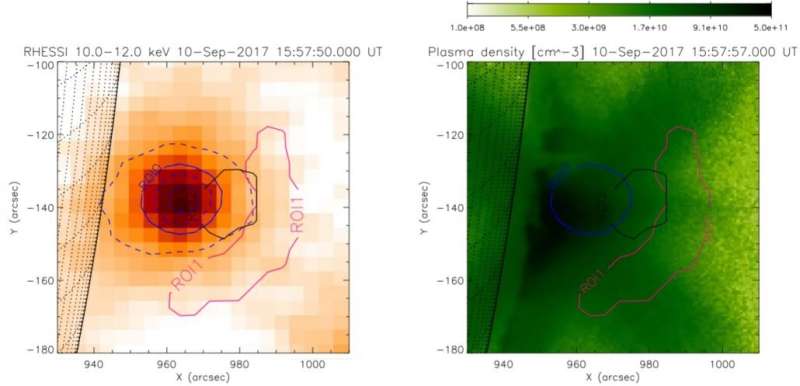This article has been reviewed according to Science X's editorial process and policies. Editors have highlighted the following attributes while ensuring the content's credibility:
fact-checked
peer-reviewed publication
trusted source
proofread
Electron acceleration efficiency during the impulsive phase of a solar flare: X-ray and microwave observations

Solar flares are known to be prolific electron accelerators, yet identifying the mechanism(s) for such efficient electron acceleration in magnetic reconnection events at the sun (and similar astrophysical settings) presents a major challenge in astrophysics. Accelerated electrons with energies above ∼20 keV are revealed by hard X-ray (HXR) bremsstrahlung emission, while accelerated electrons with even higher energies usually manifest themselves through radio gyrosynchrotron emission.
Of considerable interest is the nature of the process that accelerates particles to high energies and the ratios of the number densities (cm−3) of nonthermal and thermal electrons (nnth and nth, respectively) to the total number density of background electrons in acceleration region.
Recently Eduard Kontar and colleagues combined RHESSI HXR observations of a well-observed solar flare with contemporaneous EUV observations from the Solar Dynamics Observatory Atmospheric Imaging Assembly in order to better constrain both the total number of accelerated electrons and the all-important ratio (nnth/np) in the 10 September 2017 solar flare that revealed clear evidence for a reconnection current sheet located above the flare loop-top.
The results indicate that the ratio of nonthermal electrons to ambient electrons in ROI-1 at a time near the peak of the X-ray emission is nnth/np ≃ 0.01–0.02. The findings are published in The Astrophysical Journal Letters.
Intriguingly, the microwave spectrum analysis by Fleishman et al. using 2" pixels, which are smaller than EOVSA beam resolution of (45−5)" for the (2−18) GHz range, gives approximately 100 times larger fraction of accelerated electrons in the same region of flare.
More information: Eduard P. Kontar et al, The Efficiency of Electron Acceleration during the Impulsive Phase of a Solar Flare, The Astrophysical Journal Letters (2023). DOI: 10.3847/2041-8213/acc9b7
Journal information: Astrophysical Journal Letters
Provided by Community of European Solar Radio Astronomers





















